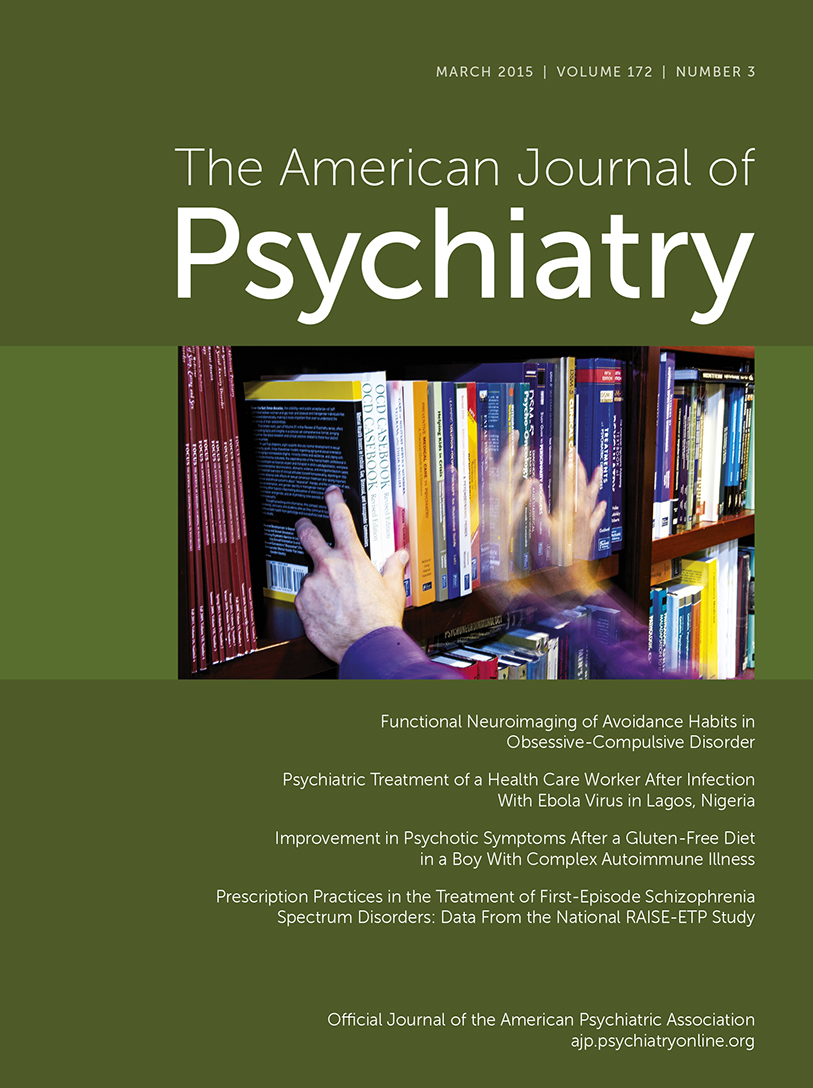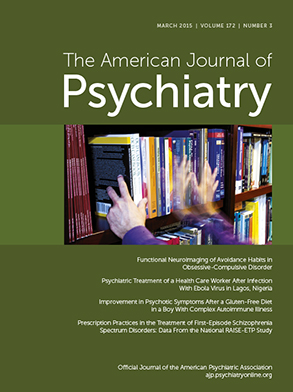Early treatment for individuals experiencing schizophrenia has received increasing attention because of its potential to alter the course of illness and improve outcomes (
1). A critical component of optimal early treatment includes appropriate use of medications. Because of differential responses to medications in first-episode and multiepisode schizophrenia, prominent guidelines suggest different treatment practices for these patient groups (
2,
3). For example, the 2010 Schizophrenia Patient Outcomes Research Team (PORT) underlines the importance of using low dosages of medication and specifies that olanzapine and clozapine should not be first-line treatments because of their risks of adverse effects (
3). Because medication experiences for individuals at the beginning of treatment may have a lasting impact on their attitudes toward medication and course of illness, this is a critical time to optimize prescribing. To the extent that adhering to the guidelines leads to better efficacy, tolerability, and positive interactions with mental health professionals, this could have a significant impact in first-episode patients.
The Recovery After an Initial Schizophrenia Episode project’s Early Treatment Program (RAISE-ETP) study is a nationwide comparative effectiveness trial that enrolled 404 individuals with a schizophrenia spectrum diagnosis at 34 community sites throughout the country. Study participants had received less than 6 months of antipsychotic treatment at enrollment. The relatively large sample and geographic breadth of the study provided the first opportunity to characterize typical community treatment of early-phase schizophrenia patients in the United States.
In this issue, Robinson et al. (
4) report on prescription practices observed in first-episode schizophrenia in the RAISE-ETP study. The investigators obtained detailed information regarding each participant’s prescribed medications at study entry and determined whether the medication treatment was consistent with practice guidelines. The investigators also examined participant- and system-level factors associated with medication patterns that did not conform to practice guidelines and therefore could “benefit from changes.”
The investigators found evidence of potentially problematic prescribing for 159 individuals (39.4% of the sample). The most common issues were use of an antidepressant along with an antipsychotic without a clear indication; prescription of olanzapine; and use of more than one antipsychotic. A small subgroup also had psychotropic medications prescribed without antipsychotics.
While the article focuses on potential prescribing problems, it is first worth noting that the prescribing for more than 60% of the sample appeared to follow existing guidelines. Given that guidelines are not meant to dictate prescribing for an individual patient, the appropriate benchmark for conformant practice is not clear. In a study of quality of schizophrenia care, Young et al. (
5) found that for 34 of 84 patients receiving poor-quality care, patient factors such as poor adherence and substance use contributed to the problematic prescribing. Some nonconformant prescribing may in fact be appropriate for particular patients given their history of treatment response, their symptoms, and their preferences. It is also important to note that prescribing that conforms to guidelines is not necessarily optimal. Guideline-conformant treatment suggests but is not synonymous with high-quality care.
Notwithstanding the limitations of prescribing guidelines, this study underlines several concerns in prescribing psychotropic medications in individuals experiencing a first episode of psychosis. With respect to antipsychotic prescribing, use of combinations of antipsychotics is not supported by evidence and may be associated with more adverse effects (
3,
6). This is particularly important in the care of individuals with first-episode psychosis, who are extraordinarily vulnerable to medication side effects (
3). The increased complexity of dosage schedules involving polypharmacy, the increased likelihood of adverse effects, and the lack of evidence for effectiveness all argue strongly against polypharmacy in this population. If two individual antipsychotics do not provide adequate benefit, evidence strongly supports and guidelines recommend using clozapine rather than combinations of antipsychotics (
2,
3).
Clinicians who rarely treat first-episode patients may not be aware of the extent of problems with olanzapine use in this population. The PORT recommends against using olanzapine as a first-line treatment. The concern is that olanzapine’s adverse metabolic effects will be particularly burdensome to young people experiencing a first episode of psychosis, who have been shown by Correll et al. (
7) in the RAISE-ETP study population to already have considerable metabolic problems. The problems of using olanzapine in this population were highlighted in the Treatment of Early-Onset Schizophrenia Spectrum disorders study, which compared the effectiveness of molindone, olanzapine, and risperidone in young patients with psychosis (
8). During the trial, randomization to olanzapine was discontinued, on the recommendation of the data and safety monitoring board, when the interim analysis found greater weight gain with olanzapine without greater efficacy. Nevertheless, the designation of olanzapine as a second-line treatment for first-episode psychosis may be controversial because of its relatively good efficacy (
9) and because close monitoring and management of adverse metabolic effects may mitigate long-term risks. It is possible that some of the olanzapine prescribed to patients in the Robinson et al. study was first started on an inpatient unit where it was used to achieve acute response with the intent to later switch to an antipsychotic associated with fewer metabolic problems. However, there is no research evidence that stabilizing a patient with olanzapine and then switching to another antipsychotic is an effective strategy. Instead of initiating a treatment with a planned subsequent change, we recommend working with patients collaboratively to select an initial medication that might work well and not require a subsequent switch.
Because of evidence that people experiencing a first episode of psychosis respond to lower dosages of antipsychotic medication and are more sensitive to adverse effects than people with multiepisode schizophrenia, PORT judiciously recommends using moderate dosages for first-episode psychosis. In fact, all patients should be treated with the lowest effective dosage of antipsychotic medication to minimize adverse effects (
10). Although the PORT recommendation for risperidone and olanzapine to use the “lower half of recommended dosage range for multiepisode patients” is sound, to operationalize nonconformant prescribing as anything above 15 mg/day of olanzapine or 5 mg/day of risperidone may seem arbitrary and an estimate rather than a precise cut-point.
Use of antidepressants in individuals with first-episode psychosis is complex. The RAISE-ETP study found antidepressant use with and without a depression indication. Even for people with both schizophrenia and depression, evidence from randomized controlled trials for adjunctive treatment with an antidepressant is weak (
11). Depressive symptoms are common in people diagnosed as having schizophrenia, but because these subsyndromal or nonspecific symptoms may improve when the psychosis is treated with antipsychotics (
12), these individuals should not automatically be treated with an antidepressant. However, using antidepressants when patients develop depression is rational, and some evidence (
13), greatly in need of replication, suggests that there may be a substantial benefit from antidepressants in reducing mortality due to suicide. For patients without evidence of depression who are treated with antidepressants, as observed in the RAISE-ETP study, it is important to understand what motivated the antidepressant treatment. Antidepressants may have been initiated in the prodromal phase to treat the relatively nonspecific prodromal symptoms. It is also possible that clinicians used antidepressants to try to treat negative symptoms of schizophrenia, for which there is some evidence of effectiveness (
14,
15). More research is needed to assess the impact of antidepressants in first-episode psychosis.
The consistent association of public insurance or lack of insurance with potentially problematic prescribing relative to those with private insurance is cause for concern. These findings raise the possibility that uninsured or publicly insured patients may have less time with prescribers and a more difficult pathway to care. This finding also underscores the fact that prescriber education and support alone are unlikely to completely eliminate problematic prescribing. A study of antipsychotic prescribing in two Italian outpatient clinics (
16) found that the clinic using higher than recommended antipsychotic dosages had fewer staff, had less treatment time for patients and families, and lacked a facility for acute inpatient care, suggesting that organizational issues had a greater impact on prescribing than did the physicians’ knowledge. Broader changes in the organization and delivery of mental health care may be necessary to reduce disparities.
We strongly advocate constructively engaging patients to choose medications and avoid any associated harms. A few points concerning prescribing for people experiencing a first episode of psychosis are worth emphasizing. First, avoid combinations of antipsychotics. Second, use the lowest effective dosage, but use clinical evaluation and judgment to determine the best dosage rather than arbitrary dosage cutoffs. Third, do not choose olanzapine or clozapine as the first medication. Clozapine does, however, have a clear role for people who do not respond to adequate trials of other drugs. Choosing clozapine sooner rather than later may be the best thing that can happen to a young person who does not get much benefit from standard treatments.
RAISE-ETP is a comprehensive study that draws attention to shortcomings in the pharmacologic treatment of young people receiving services for early schizophrenia. The stakes are potentially very high, as these early treatment experiences may establish a pattern for future illness management. The use of principles of shared decision making, in which patients and their families are engaged in a comprehensive discussion of the risks and benefits of different medication choices, is essential. Only in this context can individuals make well-informed decisions about whether to take medications, which medication to take, and at what dosage and for how long. Unfortunately, the available information, particularly about medication choice, dosage, and duration, is limited. Further research on how best to provide services and prescribe medications for individuals early in the course of psychotic illness is direly needed.

